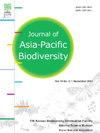Occupancy, population density, and activity patterns of endangered Sri Lankan leopard (Panthera pardus kotiya) in Kumana National Park, Sri Lanka
IF 0.7
Q4 BIODIVERSITY CONSERVATION
引用次数: 0
Abstract
Being the apex predator of Sri Lanka’s forests, the endangered Sri Lankan leopard (Panthera pardus kotiya) plays a crucial role in maintaining the balance of natural ecosystems. In this study, we aimed to address the paucity of data related to one of the major leopard habitats of the country, Kumana National Park (KNP). This study investigates the spatial occupancy, population density, and activity patterns of the Sri Lankan leopard in KNP, Sri Lanka. Our findings reveal a higher concentration of leopards around water bodies and rocky areas, which provide shelter and support prey species such as wild buffalo and spotted deer. Using random encounter models (REM) and spatially explicit capture–recapture (SECR) analyses the population density of leopards was estimated. The study identified the eastern region of KNP as having one of the highest recorded leopard densities globally, with REM and SECR estimates showing statistically similar results of approximately 41 leopards per 100 km2. This high density is attributed to the availability of prey and habitat variability that supports the ecological needs of leopards. The study underscores the importance of KNP as a stronghold of leopards in southern Sri Lanka and the necessity of preserving its natural habitats.
斯里兰卡库马纳国家公园濒危斯里兰卡豹的占用、人口密度和活动模式
作为斯里兰卡森林的顶级捕食者,濒临灭绝的斯里兰卡豹(Panthera pardus kotiya)在维持自然生态系统平衡方面发挥着至关重要的作用。在这项研究中,我们旨在解决与该国主要豹子栖息地之一库马纳国家公园(KNP)相关的数据缺乏问题。本研究调查了斯里兰卡KNP地区斯里兰卡豹的空间占用、种群密度和活动模式。我们的研究结果显示,豹子在水体和岩石地区周围的集中度更高,这些地区为野生水牛和斑点鹿等猎物提供庇护和支持。采用随机相遇模型(REM)和空间显式捕获-再捕获(SECR)分析方法估计了豹子的种群密度。研究发现,KNP的东部地区是全球有记录的豹密度最高的地区之一,REM和SECR的估计结果在统计上相似,每100平方公里约有41只豹。这种高密度归因于猎物的可用性和栖息地的可变性,这支持了豹子的生态需求。该研究强调了KNP作为斯里兰卡南部豹子大本营的重要性,以及保护其自然栖息地的必要性。
本文章由计算机程序翻译,如有差异,请以英文原文为准。
求助全文
约1分钟内获得全文
求助全文
来源期刊

Journal of Asia-Pacific Biodiversity
Agricultural and Biological Sciences-Insect Science
CiteScore
1.70
自引率
12.50%
发文量
94
审稿时长
27 days
期刊介绍:
The Journal of Asia-Pacific Biodiversity (previous title was Journal of Korean Nature) is an official journal of National Science Museum of Korea (NSMK) and Korea National Arboretum (KNA). The scope of journal is wide and multidisciplinary that publishes original research papers, review articles, as well as conceptual, technical and methodological papers on all aspects of biological diversity-its description, analysis and conservation, and its application by humankind. This wide and multidisciplinary journal aims to provide both scientists and practitioners in conservation theory, policy and management with comprehensive and applicable information. However, papers should not be submitted that deal with microorganisms, except in invited paper. Articles that are focused on the social and economical aspects of biodiversity will be normally not accepted.
 求助内容:
求助内容: 应助结果提醒方式:
应助结果提醒方式:


